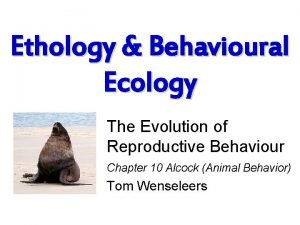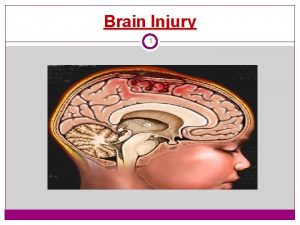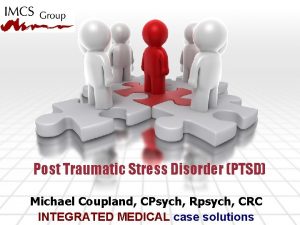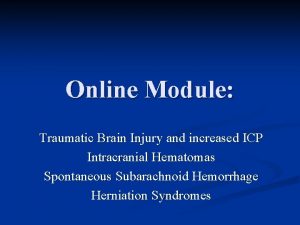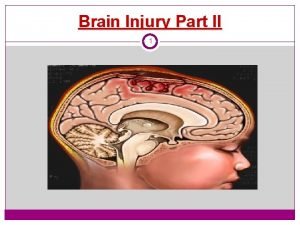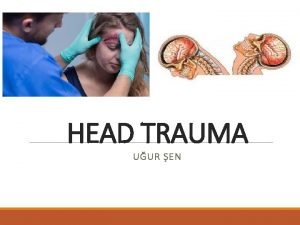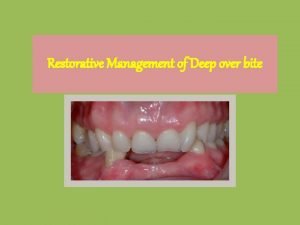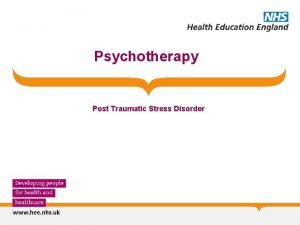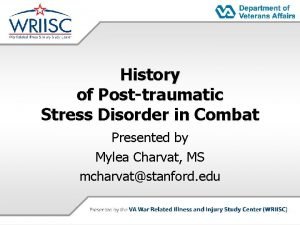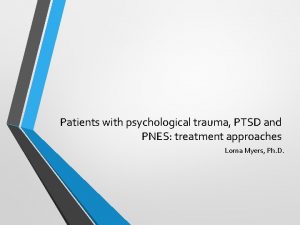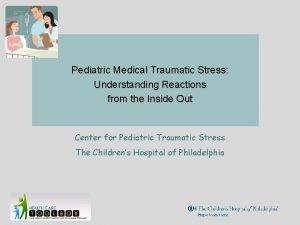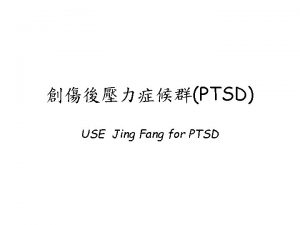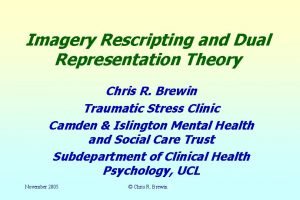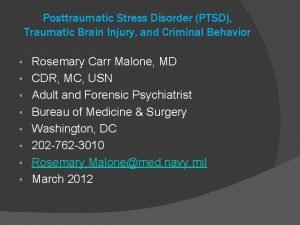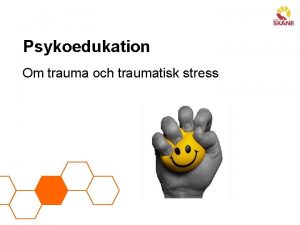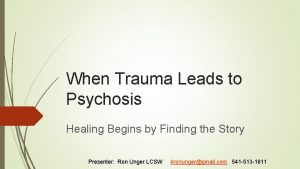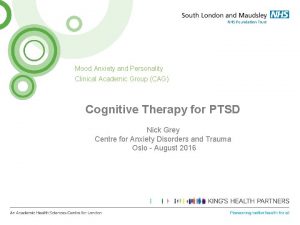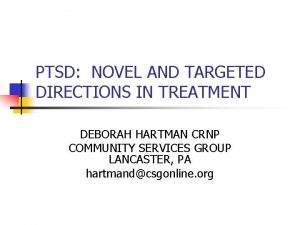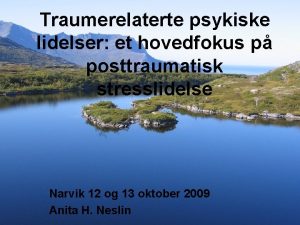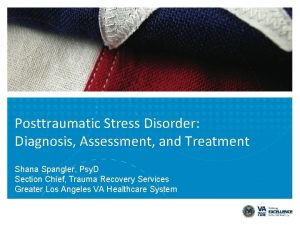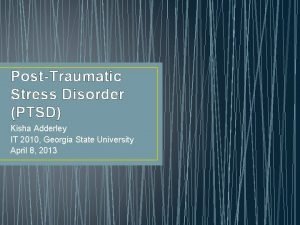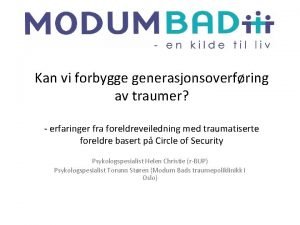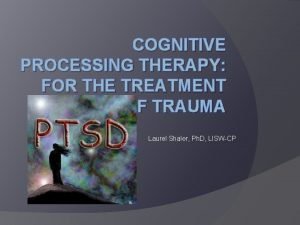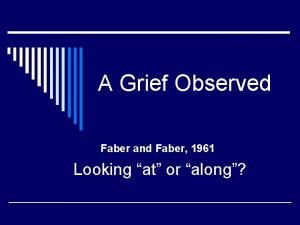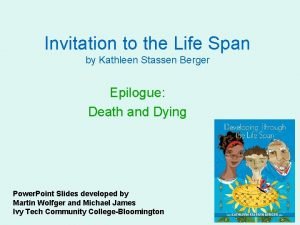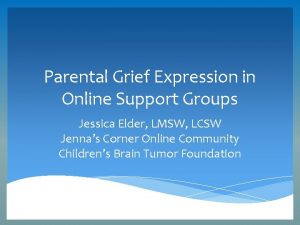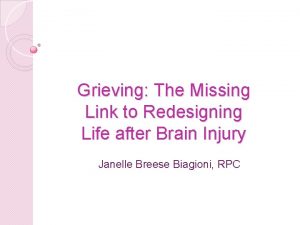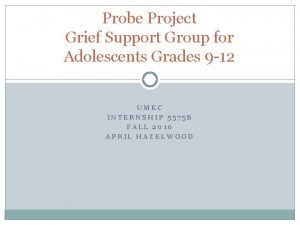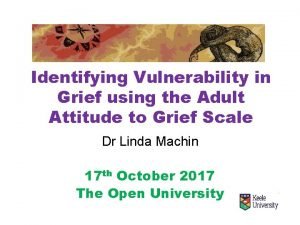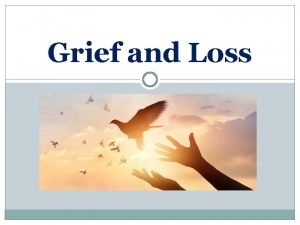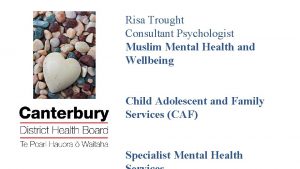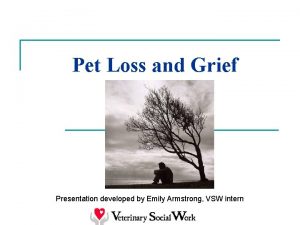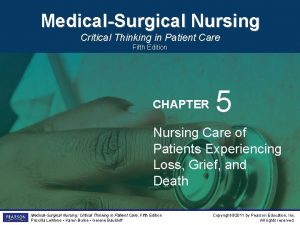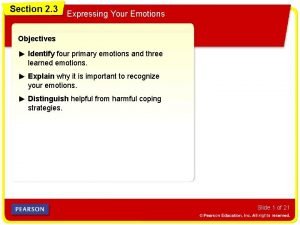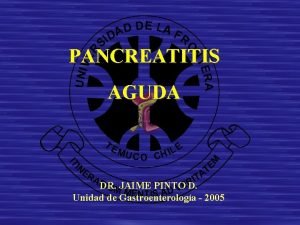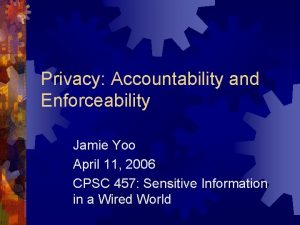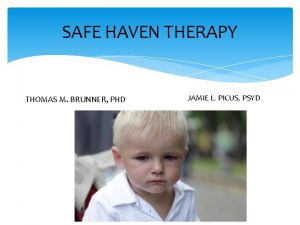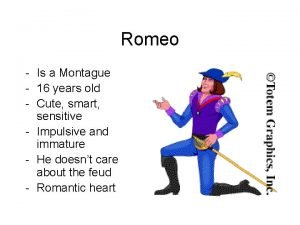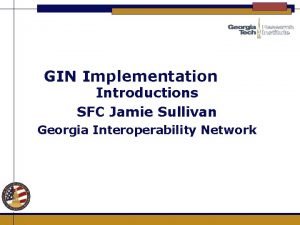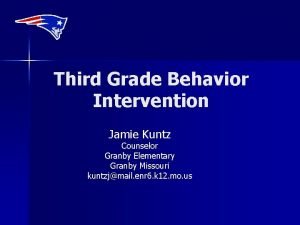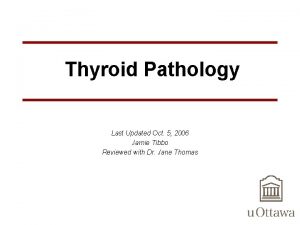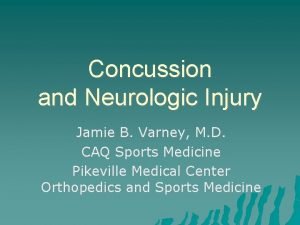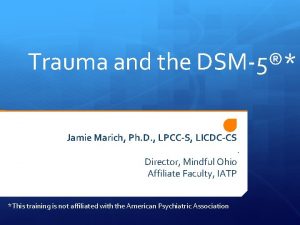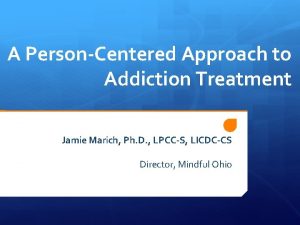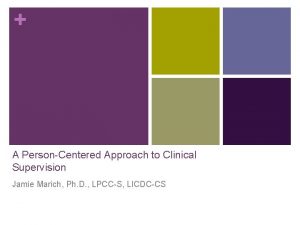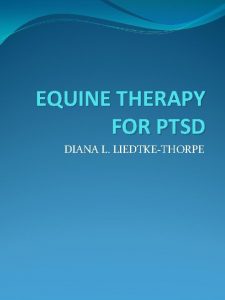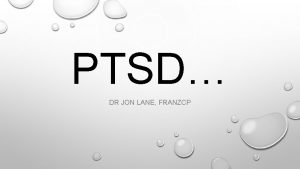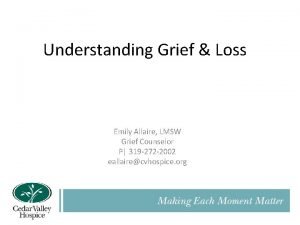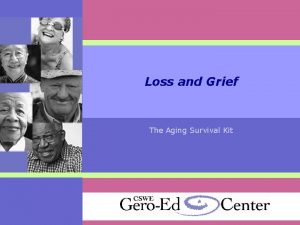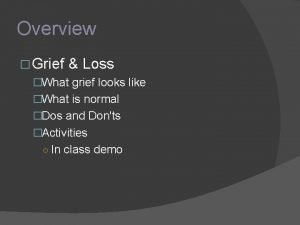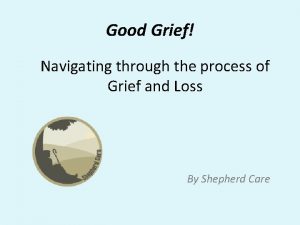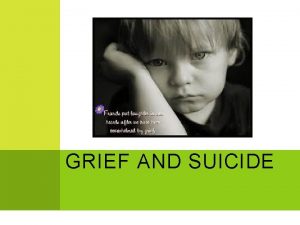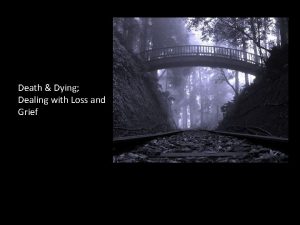Trauma PTSD Traumatic Grief Jamie Marich Ph D















































































































- Slides: 111

Trauma, PTSD & Traumatic Grief Jamie Marich, Ph. D. , LPCC-S, LICDC-CS Youngstown/Warren, OH Affiliate Faculty, International Association of Trauma Professionals

About Your Presenter • Licensed Supervising Professional Clinical Counselor • Licensed Independent Chemical Dependency Counselor • Affiliate Faculty, International Association of Trauma Professionals (IATP) • 13 years of experience working in social services and counseling; includes three years in civilian humanitarian (Bosnia. Hercegovina) • Specialist in addictions, trauma, EMDR, dissociation, performance enhancement, grief/loss, mindfulness, and pastoral counseling • Author of EMDR Made Simple, Trauma and the Twelve Steps, and Trauma Made Simple (forthcoming) • Creator of the Dancing Mindfulness practice

What led you to today’s workshop?

Learning Objectives • Describe the etiology and impact of traumatic stress on the client utilizing evaluation tools. • Assess a client’s reaction to a traumatic event, Acute Stress Disorder and PTSD • Explain the DSM-5® changes as they relate to both PTSD and griefrelated disorders • Implement interventions to assist a client in dealing with the physical manifestations of trauma/PTSD/traumatic grief • Utilize appropriate evidence-based interventions to assist a client in dealing with the psycho/socio/emotional manifestations of trauma/PTSD/traumatic grief • Explain the effect of trauma on the structure and function of the brain

www. traumatwelve. com/powerpoint

Trauma

“Once you’ve been bitten by a snake, you’re afraid even of a piece of rope. ” -Chinese Proverb

Etymology What does the word trauma mean?

Etymology • Trauma comes from the Greek word meaning wound • What do we know about physical wounds and how they heal?

Etymology Appreciating the wound metaphor is the heart of understanding emotional trauma and how to treat it.


DSM • PTSD entered into the DSM-III in 1980, largely as a result of the Vietnam War • Other names had been used unofficially in the field over the years: soldier’s heart shell shock battle fatigue operational exhaustion hysteria

DSM-IV-TR Nutshell Definition of PTSD Posttraumatic Stress Disorder (APA, 2000) • Actual or perceived threat of injury or death- response of hopelessness or horror (Criterion A) • Re-experiencing of the trauma • Avoidance of stimuli associated with the trauma • Heightened arousal symptoms • Duration of symptoms longer than 1 month • Functional impairment due to disturbances

DSM-5® Nutshell Definition of PTSD Posttraumatic Stress Disorder (APA, 2013) • Exposure to actual or threatened a) death, b) serious injury, or c) sexual violation: direct experiencing, witnessing • Intrusion symptoms • Avoidance of stimuli associated with the trauma • Cognitions and Mood: negative alterations • Arousal and reactivity symptoms • Duration of symptoms longer than 1 month • Functional impairment due to disturbances

Posttraumatic Stress Disorder: DSM-5® Criteria A. Exposure to actual or threatened death, serious injury, or sexual violence, in one (or more) of the following ways: 1. Directly experiencing the traumatic event(s). 2. Witnessing, in person, the traumatic event(s) as it occurred to others. 3. Learning that the traumatic event(s) occurred to a close family member or close friend; cases of actual or threatened death must have been violent or accidental. 4. Experiencing repeated or extreme exposure to aversive details of the traumatic event(s) (e. g. , first responders collecting human remains; police officers repeatedly exposed to details of child abuse); this does not apply to exposure through electronic media, television, movies, or pictures, unless this exposure is work-related.

Posttraumatic Stress Disorder: DSM-5® Criteria B. Presence of one (or more) of the following intrusion symptoms associated with the traumatic event(s), beginning after the traumatic event(s) occurred: 1. Recurrent, involuntary, and intrusive distressing memories of the traumatic event(s). (Note: In children older than 6 years, repetitive play may occur in which themes or aspects of the traumatic event(s) are expressed. ) 2. Recurrent distressing dreams in which the content and/or affect of the dream are related to the traumatic event(s). (Note: In children, there may be frightening dreams without recognizable content. ) 3. Dissociative reactions (e. g. , flashbacks) in which the individual feels or acts as if the traumatic event(s) are recurring. (Such reactions may occur on a continuum, with the most extreme expression being a complete loss of awareness of present surroundings. ) (Note: In children, trauma-specific reenactment may occur in play. ) 4. Intense or prolonged psychological distress at exposure to internal or external cues that symbolize or resemble an aspect of the traumatic event(s). 5. Marked physiological reactions to internal or external cues that symbolize or resemble an aspect of the traumatic event(s). reminders of the traumatic event(s)

Posttraumatic Stress Disorder: DSM-5® Criteria C. Persistent avoidance of stimuli associated with the traumatic event(s), beginning after the traumatic event(s) occurred, as evidenced by one or both of the following: 1. Avoidance of or efforts to avoid distressing memories, thoughts, or feelings about or closely associated with the traumatic event(s). 2. Avoidance of or efforts to avoid external reminders (people, places, conversations, activities, objects, situations) that arouse distressing memories, thoughts, or feelings about or closely associated with the traumatic event(s).

Posttraumatic Stress Disorder: DSM-5® Criteria D. Negative alterations in cognitions and mood associated with the traumatic event(s), beginning or worsening after the traumatic event(s) occurred, as evidenced by two (or more) of the following: 1. Inability to remember an important aspect of the traumatic event(s) (typically due to dissociative amnesia and not to other factors such as head injury, alcohol, or drugs) 2. Persistent and exaggerated negative beliefs or expectations about oneself, others, or the world (e. g. , “I am bad, ” “No one can be trusted, ” "The world is completely dangerous, “ “My whole nervous system is permanently ruined”). 3. Persistent, distorted cognitions about the cause or consequences of the traumatic event(s) that lead the individual to blame himself/herself or others. 4. Persistent negative emotional state (e. g. , fear, horror, anger, guilt, or shame). 5. Markedly diminished interest or participation in significant activities. 6. Feelings of detachment or estrangement from others. 7. Persistent inability to experience positive emotions (e. g. , inability to experience happiness, satisfaction, or loving feelings).

Posttraumatic Stress Disorder: DSM-5® Criteria E. Marked alterations in arousal and reactivity associated with the traumatic event(s), beginning or worsening after the traumatic event(s) occurred, as evidenced by two (or more) of the following: 1. Irritable behavior and angry outbursts (with little or no provocation) typically expressed as verbal or physical aggression toward people or objects. 2. Reckless or self-destructive behavior. 3. Hypervigilance. 4. Exaggerated startle response. 5. Problems with concentration. 6. Sleep disturbance (e. g. , difficulty falling or staying asleep or restless sleep).

Posttraumatic Stress Disorder: DSM-5® Criteria F. Duration of the disturbance (Criteria B, C, D, and E) is more than 1 month. G. The disturbance causes clinically significant distress or impairment in social, occupational, or other important areas of functioning. H. The disturbance is not attributable to the physiological effects of a substance (e. g. , medication, alcohol) or another medical condition.

Posttraumatic Stress Disorder: DSM-5® Criteria Specify whether: With dissociative symptoms: The individual’s symptoms meet the criteria for posttraumatic stress disorder, and in addition, in response to the stressor, the individual experiences persistent or recurrent symptoms of either of the following: 1. Depersonalization: Persistent or recurrent experiences of feeling detached from, and as if one were an outside observer of, one’s mental processes or body (e. g. , feeling as though one were in a dream; feeling a sense of unreality of self or body or of time moving slowly). 2. Derealization: Persistent or recurrent experiences of unreality of surroundings (e. g. , the world around the individual is experienced as unreal, dreamlike, distant, or distorted). Note: To use this subtype, the dissociative symptoms must not be attributable to the physiological effects of a substance (e. g. , blackouts, behavior during alcohol intoxication) or another medical condition (e. g. complex partial seizures). Specify if: With Delayed Expression: If the full diagnostic criteria are not met until at least 6 months after the event (although the onset and expression of some symptoms may be immediate). Subtype: PTSD in children younger than 6 years

DSM-5®: Trauma & Stressor-Related Disorders • • Reactive Attachment Disorder Disinhibited Social Engagement Disorder Acute Stress Disorder Posttraumatic Stress Disorder Adjustment Disorders Other Specified Trauma-and-Stressor Related Disorder Unclassified Trauma-and-Stressor Related Disorder

Trauma: “small-t” • Adverse life experiences • Not necessarily life threatening, but definitely life-altering • Examples include grief/loss, divorce, verbal abuse/bullying, and just about everything else… • The trauma itself isn’t the problem—rather, does it get addressed? Is the wound given a chance to heal? • If it was traumatic to the person, then it’s traumatic. • According to the adaptive information processing model, these adverse life experiences can be just as valid and just as clinically significant as PTSD-eligible traumas.

BREAK TIME

Worden (2002/2008) • Grief is the experience of loss in one’s life • Bereavement defines the loss to which a person is trying to adapt • Mourning is the process one goes through adapting to the loss • Complicated mourning: when the adaptation is insufficient, it leads to functional impairment

George Engel, M. D. (1961) “Loss of a loved one is psychologically traumatic to the same extent that being severely wounded or burned is physiologically traumatic. ” The process of mourning is parallel to the process of physical healing.

Grief, Mourning & DSM-5® • Removal of the bereavement exclusion from the major depressive disorder diagnosis • New Section III Diagnosis: Persistent Complex Bereavement Disorder

Persistent Complex Bereavement Disorder: DSM-5® Criteria A. The individual experienced the death of someone with whom he or she had a close relationship. B. Since the death, at least one of the following symptoms is experienced on more days than not and to a clinically significant degree and has persisted for at least 12 months after the death in the case of bereaved adults and 6 months for bereaved children: 1. Persistent yearning/longing for the deceased. In young children, yearning may be expressed in play and behavior, including behaviors that reflect being separated from, and also reuniting with, a caregiver or other attachment figure. 2. Intense sorrow and emotional pain in response to the death. 3. Preoccupation with the deceased. 4. Preoccupation with the circumstances of the death. In children, this preoccupation with the deceased may be expressed through themes of play and behavior and may extend to preoccupation with possible death of others close to them.

Persistent Complex Bereavement Disorder: DSM-5® Criteria C. Since the death, at least six of the following symptoms are experienced on more days than not and to a clinically significant degree, and have persisted for at least 12 months after the death in the case of bereaved adults and 6 months for bereaved children: Reactive distress to the death 1. Marked difficulty accepting the death. In children, this is dependent on the child’s capacity to comprehend the meaning and permanence of death. 2. Experiencing disbelief or emotional numbness over the loss. 3. Difficulty with positive reminiscing about the deceased. 4. Bitterness or anger related to the loss. 5. Maladaptive appraisals about oneself in relation to the deceased or the death (e. g. , self-blame). 6. Excessive avoidance of reminders of the loss (e. g. , avoidance of individuals, places, or situations associated with the deceased); in children, this may include avoidance of thoughts and feelings regarding the deceased.

Persistent Complex Bereavement Disorder: DSM-5® Criteria Social/Identity Disruption 7. A desire to die in order to be with the deceased. 8. Difficulty trusting other individuals since the death. 9. Feeling alone or detached from other individuals since the death. 10. Feeling that life is meaningless or empty without the deceased, or the belief that one cannot function without the deceased. 11. Confusion about one’s role in life or a diminished sense of one’s identity (e. g. , feeling that a part of oneself died with the deceased). 12. Difficulty or reluctance to pursue interests since the loss or to plan for the future (e. g. , friendships, activities).

Persistent Complex Bereavement Disorder: DSM-5® Criteria D. The disturbance causes clinically significant distress or impairment in social, occupational, or other important areas of functioning. E. The bereavement reaction is out of proportion to or inconsistent with cultural, religious, or age-appropriate norms. Specify if: With Traumatic Bereavement: bereavement due to homicide or suicide with persistent distressing preoccupations regarding the traumatic nature of the death (often in response to loss reminders), including the deceased’s last moments, degree of suffering and mutilating injury, or the malicious or intentional nature of the death

The Classic Kübler-Ross (1969) “Stages” • • • Denial Anger Bargaining Depression Acceptance Have you ever thought of a client as being stuck in this process?

A Client’s Perspective: Lily Burana (2009) “That whole Kubler-Ross thing? The separate stages of Denial, Anger, Bargaining, Dorothy and Toto, or whatever? TOTAL CRAP. What you get when someone dies is all those feelings ALL AT ONCE, warping and spinning around like grief’s bad trip. ”


A Client’s Perspective: Lily Burana (2009) “PTSD means, in ‘talking over beer’ terms, that you’ve got some crossed wires in your brain due to the traumatic event. The overload of stress makes your panic button touchier than most people’s, so certain things trigger a stress reaction- or more candidly- an over-reaction. Sometimes, the panic button gets stuck altogether and you’re in a state of constant alert, buzzing and twitchy and aggressive. ”

A Client’s Perspective: Lily Burana (2009) “Your amygdala- the instinctive flight, fight, or freeze part of your brain- reacts to a trigger before your rational mind can deter it. You can tell yourself, ‘it’s okay, ’ but your wily brain is already ten steps ahead of the game, registering danger and sounding the alarm. So you might say once again, in a calm, reasoned cognitivebehavioral-therapy kind of way, ‘Brain, it’s okay…’

A Client’s Perspective: Lily Burana (2009) “But your brain yells back, ‘Bullshit kid, how dumb do you think I am? I’m not falling for that one again. ’ By then, you’re hiding in the closet, hiding in a bottle, and/or hiding from life, crying, raging, or ignoring the phone and watching the counter on the answering machine go up, up, and up. You can’t relax, and you can’t concentrate because the demons are still pulling at your strings. ”

A Client’s Perspective: Lily Burana (2009) “The long-range result is that the peace of mind you deserve in the present is held hostage by the terror of your past. ”




Putting it Simply • Cognitive-behavioral, talk therapies primarily target the prefrontal regions of the brain (e. g. , thinking, judgment, and willpower). • However, when a person gets activated or triggered by traumatic memories or other visceral experiences, the prefrontal cortex is likely to shut down and the limbic brain (e. g. , emotional brain) takes over. • Just talking can activate the emotional, limbic brain, but just talking is not very likely to calm it back down. • What does not seem to change with traditional talk therapy is that uncomfortable experience of being triggered at a visceral level.

Putting it Simply • Thus, our therapeutic interventions must address the entire brain. • Another way to look at processing is to think of these three brains “linking up. ”

What Does it Mean to Process Something? ? ?

Trauma and the Adaptive Information Processing Model (Part I) § Memory networks are the basis of perception, attitude and behavior…they inform the present. § The information processing system moves disturbance to an adaptive resolution…the events that don’t get processed through adaptively give us problems later in life. § Disruption of the information processing system causes information (e. g. , seen, heard, felt) to be unprocessed and inappropriately stored as it was perceived. (SOURCE: Shapiro, 2001; Shapiro & Solomon, 2008)

Unprocessed and inappropriately stored as it was perceived = STUCK material that causes disturbance

How can something then get “unstuck”?

Trauma and the Adaptive Information Processing Model (Part II) • Accessing information allows link between consciousness and where information is stored • Information processing transmutes through all accessed channels of memory networks • The unprocessed components/manifestations of memory (image, thought, sound, emotions, physical sensations, beliefs) change/transmute during processing to an adaptive resolution (SOURCE: Shapiro, 2001; Shapiro & Solomon, 2008)

Trauma and the Adaptive Information Processing Model (Part III) • Byproducts of reprocessing include desensitization (lessening of disturbance), insights, changes in physical and emotional responses (SOURCE: Shapiro, 2001; Shapiro & Solomon, 2008)

A Client’s Perspective: from Marich (2010) Fadalia (pseudonym), a recovering heroin addict with complex trauma reflected on where she was at before receiving the integrated treatment that led to her longest sobriety to date (3 years): “Before [treatment], my feelings, thoughts and experiences were all tangled like a ball of yarn. I needed something to untangle them. ”


From Jaycee Dugard (2011) “This book might be confusing to some. But keep in mind throughout my book that this was a very confusing world I lived in. I think to truly begin to understand what it was like, you would have had to be there, and since I wish that on no one, this book is my attempt to convey the overwhelming confusion I felt during those years and to begin to unravel the damage that was done to me and my family.

From Jaycee Dugard (2011) You might be suddenly reading about a character that was never introduced , but that’s how it was for me. It didn’t feel like a sequence of events. Even after I was freed, moments are fragmented and jumbled. With some help, I have come to realize that my perspective is unique to abduction. I don’t want to lose that voice, and therefore I have written the book how it came to me naturally. I’m not the average storyteller…I’m me…and my experience is very uncommon. Yes, I jump around with tangents, but that’s somehow the way my mind works. If you want a less confusing story, come back to me in ten years from now when I sort it all out!” (p. viii).

Assessment as Intervention

• Primary Care PTSD Screen • The PTSD Checklist • Catalogue of Resources on the National Center for PTSD Website http: //www. ptsd. va. gov/

How Do I Expand My Addiction Knowledge, Even If I’m Not an “Addiction” Provider?

Ricci and Clayton (2008) “Trauma may also disintegrate any sense of a future, thus fostering a propensity for the pursuit of instant gratification” (p. 42).

Assessment Strategy The “Greatest Hits” List of Problematic Beliefs The “Greatest Hits” List of Addiction-Specific Beliefs Sometimes it is difficult for clients to pinpoint one specific memory in addressing trauma. However, they are more likely to be able to select a pattern of thoughts they have had about themselves after seeing these lists. This is often a good starting point to developing a treatment plan.

"When tragedies strike we try to find someone to blame, and in the absence of a suitable candidate we usually blame ourselves. ” -Maggie Smith, as The Dowager Countess of Grantham

“The Whitney I knew, despite her success and worldwide fame, still wondered: Am I good enough? Am I pretty enough? Will they like me? It was the burden that made her great. . . So off you go, Whitney, off you go. . . escorted by an army of angels to your Heavenly Father. And when you sing before Him, don’t you worry — you’ll be good enough. ” -from Kevin’s Costner’s eulogy

February 20, 1968 Dear Mother— From all indications I’m going to become rich and famous. All sorts of magazines are asking to do articles and pictures featuring me. I’m going to do every one. Wow, I’m so lucky- I just fumbled around being a mixed up kid and then I fell into this. And finally it looks like everything is going to work out for me. I’m awfully sorry to be such a disappointment to you. I understand your fears at my coming here and must admit I share them, but I really do think there’s an awfully good chance I won’t blow it this time. There’s really nothing more I can say now. Guess I’ll write more when I have more news, until then, address all criticism to the above address. And please believe me that you can’t possibly want for me to be a winner more than I do. Love, Janis Source: Joplin, L. (2004)

Best Practices for Assessment • Do not re-traumatize! • Do ask open-ended questions • Do be genuine, build rapport from the first greeting • Do consider the role of shame in addiction, trauma, and grief • Do be non-judgmental • Do make use of the stop sign when appropriate • Do assure the client that they may not be alone in their experiences (if appropriate) • Do have closure strategies ready

Now It’s Your Turn • Write up a brief case synopsis: An actual client (using a pseudonym) A composite client A “famous” example (presenting for clinical attention) A fictitious case

Discussion: Your Reactions and Experiences

“When we honestly ask ourselves which person in our lives means the most to us, we often find that it is those who, instead of giving advice, solutions, or cures, have chosen rather to share our pain and touch our wounds with a warm and tender hand. ” -Henri Nouwen

The Case of Anna: Qualities of a Good Therapist (Marich, 2014) • To know and understand a client’s diagnosis. • To get to know you, where you're at (are you externally and internally safe? ? ? ), where you've come from (historical context; triggers, traumas, what to be aware of), and where you want to go (short- and long-term goals). • To be a person who believes in TEAMWORK. Both the professional and the client do work, lots of it. There is not an aggressor in the equation, ever. When/if it happens, stop.

The Case of Anna: Qualities of a Good Therapist (Marich, 2014) • To have compassion and empathy—NOT PITY, ever. I have seen pathological psychiatrists who don't like humans. Pity is just destructive to what is supposed to be happening: growth and healing. Pity is never a foundation for that. • To have a sense of connectedness. For people without a diagnosis, when they're going through a hard time, the baseline is to find someone you connect with. • To never, never put their own moral thing (e. g. , Christianity) above the code of treatment. Ever!!!!! No dogma at all should be in the way of the client finding her way.

The Case of Anna: Qualities of a Good Therapist (Marich, 2014) “Bad therapy is worse than no therapy. I have learned this experientially. ” -Anna

Please Return by 1: 00 pm

www. traumatwelve. com/powerpoint

TREATMENT

From Dr. Bessel Van Der Kolk “The purpose of trauma treatment is to help a person feel safe in his or her own body. ” -from the new documentary Trauma Treatment for the 21 st Century (Premier, 2012)

General Consensus Model of Trauma Treatment • PHASE I: Stabilization • PHASE II: Processing of Trauma • PHASE III: Reintegration

Guiding Principles • Before any clinician can engage in past-oriented trauma treatments focused on resolution, a set of coping skills must be in place. • It is vital that a person has tools to cope with intense affect, and it is equally vital that he/she will not come “unglued” during processing/reprocessing work. • Cultivation of resources, strengths, and other recovery capital is also an essential function of reintegration • Therapeutic relationship elements and boundary setting are also imperative

Guiding Principles • The stages are fluid. If you work in outpatient, you are doing reintegration work all along. You may be in the reprocessing stage and it becomes clear a person cannot stabilize sufficiently at the end of sessions, so you may need to go back into stabilization work. • It is hard to put trauma work into a “neat stage model”

What Types of Coping Skills Work Best? ? ? • • • Muscle relaxation Breath work Pressure Points/Tapping Yoga Imagery/Multisensory Soothing Anything that incorporates the body in a positive, adaptive way!!!

Progressive Muscle Relaxation

Breathing Basics ”The mind controls the body, but the breath controls the mind. “ B. K. S. Iyengar

Breathing Basics ”Teaching breathing exercises to your client is like teaching a teenager when to accelerate and when to brake the car. “ Amy Weintraub

Practicing Awareness of Breath

Breathing Basics • Diaphragmatic breathing • Complete breathing • Ujjayi breathing

Breathing Basics • Dr. Andrew Weil (2010) http: //www. drweil. com/drw/u/ART 00521/thre e-breathing-exercises. html • A-B-C of Yoga (2010) http: //www. abc-of-yoga. com/pranayama/

Breathing Basics • Clients who are easily activated may not feel comfortable closing their eyes during breath work. Reiterate that it is not necessary to close the eyes during these exercises. • Start slowly…if a client is not used to breathing deliberately, don’t overwhelm him. Starting with a few simple breaths, and encouraging repetition as a homework assignment, is fine. • If a client has a history of respiratory difficulties, make sure to obtain a release to speak with her medical provider before proceeding.

Pressure Points u. Sea of Tranquility u. Letting Go/Butterfly Hug u. Gates of Consciousness u. Third Eye (and variations) u. Karate Chop

Yoga • Dr. Bessel Van Der Kolk is a leading research proponent of using yoga as a primary and adjunctive treatment for PTSD • Yoga, if integrated safely and appropriately, is at very least, an ideal coping skill technique in traumatized individuals • Many high profile addiction treatment centers throughout the world offer yoga

Yoga • Recommendation:

Guided Imagery • The purpose of guided imagery as a stabilization coping exercise is to provide the client with a safe, healthy mental escape that he/she can access when needed • If you do not feel comfortable to develop your own guided imageries, there are many free scripts available online, use with caution to context • Avoid “place” guided imageries until you see how a client is going to respond

Variations Other Than Imagery • • Sound Smell Touch/Tactile Taste

Mindfulness means paying attention in a particular way: on purpose, in the presence of the moment, and non-judgmentally. -Jon Kabat-Zinn (2011)

Acceptance • acceptance as Buddhist mindfulness principle • 12 -step recovery (Alcoholics Anonymous, 2001; p. 417) • ”radical acceptance” (from dialectical behavioral therapy) • Acceptance and Commitment Therapy (ACT)

Empowerment • Encourage that change is possible, no matter how chronic the relapser… be sincere about it (Marich, 2010). • Foster identification as a survivor, not a victim (Hantman & Solomon, 2007) • Promote choice at every junction (Marich, 2014)

Recommendations

Recommendations

BREAK TIME

Factors to Consider Before Going Farther • Does the client have a reasonable amount of coping skills to access? • Is there a sufficient amount of positive material in the client’s life? • What is the nature of the living situation (safety)? • Have you looked at the picture with drug/alcohol use, including psychotropic medication? • Is the client willing (and ready) to look at past issues? • Have you assessed for secondary gains and other related issues? • Have you considered number of sessions

Review: (Re)Processing • I am not good enough • I am good enough


So, What Works for Trauma Processing? • A meta-analysis examining all studies on bona fide treatments for PTSD (e. g. , desensitization, hypnotherapy, PD, TTP, EMDR, Stress Inoculation, Exposure, Cognitive, CBT, Present Centered, Prolonged exposure, TFT, Imaginal exposure) conducted between 1989 -2007 found no statistical significance amongst the treatments (Benish, Impel, & Wampold, 2008). • The only factor leading to any statistically significant impact was therapist allegiance.

Bisson & Andrew (2007) • Meta-analysis of over 30 studies about PTSD over an 8 year period (1996 -2004) • Past-oriented PTSD treatments were far superior to coping skill only PTSD treatments • Past-oriented or trauma-oriented treatments can include past-oriented cognitive behavioral therapy, exposure therapy, hypnosis, or EMDR

The Common Factors • Client and extratherapeutic factors • Models and techniques that work to engage and inspire the participants • The therapeutic relationship/alliance • Therapist factors Source: Duncan, B. L. , Miller, S. D. , Wampold, B. E. , Hubble, M. E. (2009). The heart and soul of change: Delivering what works in psychotherapy. (2 nd ed. ) Washington, D. C. : American Psychological Association.

This Leaves You with the Following Options: Accelerated Experiential Dynamic Psychotherapy Acceptance and Commitment Therapy Art Therapy Dialectical Behavioral Therapy The Developmental Needs Meeting Strategy Emotional Freedom Technique EMDR Energy Psychology Equine-Assisted/Pet Therapy Exposure Therapy Focusing Gestalt Therapy Hakomi Hypnosis & Hypnotherapy Internal Family Systems Therapy Interpersonal Neurobiology Life Span Integration Therapy Mindfulness Based Cognitive Therapy Narrative Therapy Neurofeedback Neurolinguistic Programming Neuroemotional Technique ® Play Therapy Psychodrama/Drama Therapy Psychodynamic therapy Sensorimotor Psychology ® Somatic Experiencing ® Stress Innoculation Systematic Desensitization Trauma-Focused Cognitive Behavioral Therapy Yoga Therapy

Where Am I at With Trauma?

Why it Matters • The literature in general traumatic stress studies suggests that therapeutic alliance between client and clinician is an important mechanism in facilitating meaningful change for clients with complex PTSD (Fosha, 2000; Fosha & Slowiaczek, 1997; Courtois & Pearlman, 2005; Keller, et al. , 2010)

Qualities of a Good Trauma Therapist Parnell (2007) • • • Good clinical skills Ability to develop rapport with clients Comfort with trauma and intense affect Well-grounded Spacious Attuned to clients

Qualities of a Good EMDR/Trauma Therapist Marich (2010) caring trustworthy intuitive natural connected comfortable with trauma work skilled accommodating magical wonderful good common sense smart consoling validating gentle nurturing facilitating

Beutler, et al. (2005) On the Connection Between Therapist Traits & Client Outcomes • Effective therapists are interested in people as individuals • Have insight into their own personality characteristics • Have concern for others • Intelligent • Sensitive to the complexities of human motivation • Tolerant • Able to establish warm and effective relationships with others

Charman (2005) • • • mindful not having an agenda having concern for others intelligent flexible in personality intuitive self-aware knows own issues able to take care of self open patient creative

Intense Affect & Abreaction • “The therapeutic process of bringing forgotten or inhibited material (i. e. , experiences, memories) from the unconscious into consciousness, with concurrent emotional release and discharge of tension and anxiety. ” APA Dictionary of Psychology; Vanden. Bos (2007)

For Continued Development • How many of the qualities on these lists do I possess? • How do I handle intense affect and abreaction? • What are my personal barriers with grief and trauma? • What factors may inhibit me from being effective with someone struggling with trauma and/or grief? • When is the best time to use collaborative referrals?

www. traumatwelve. com/powerpoint

To contact today’s presenter: Jamie Marich, Ph. D. , LPCC-S, LICDC-CS Mindful Ohio jamie@jamiemarich. com www. mindfulohio. com www. jamiemarich. com www. drjamiemarich. com www. dancingmindfulness. com www. Trauma. Twelve. com Phone: 330 -881 -2944
 Traumatic insemination
Traumatic insemination Halo effect csf
Halo effect csf Post traumatic stress disorder
Post traumatic stress disorder Tbi long term servival after traumatic
Tbi long term servival after traumatic Post-traumatic cervical dystonia
Post-traumatic cervical dystonia Csf traumatic tap
Csf traumatic tap Tonsillar herniation
Tonsillar herniation Traumatic brain injury concept map
Traumatic brain injury concept map Post traumatic stress disorder
Post traumatic stress disorder Traumatic subdural hematoma
Traumatic subdural hematoma Traumatic overbite definition
Traumatic overbite definition Cptsd.
Cptsd. Blunt traumatic asphyxia
Blunt traumatic asphyxia Evolution of ptsd
Evolution of ptsd Ptsd seizures
Ptsd seizures Ptsd stages
Ptsd stages Ptsd circumcision
Ptsd circumcision Well myself and somebody else and somebody else analysis
Well myself and somebody else and somebody else analysis Macbeth nihilism quote
Macbeth nihilism quote Ptsd
Ptsd Dual representation theory
Dual representation theory Ptsd violent behavior
Ptsd violent behavior Psykoedukation ptsd
Psykoedukation ptsd Psychosis and ptsd
Psychosis and ptsd Ptsd model ehlers and clark
Ptsd model ehlers and clark Jamal and deborah therapy
Jamal and deborah therapy Ptsd spiritual warfare
Ptsd spiritual warfare Strukturell dissociation
Strukturell dissociation Ptsd norsk
Ptsd norsk Va ptsd rating scale pdf
Va ptsd rating scale pdf Causes of ptsd
Causes of ptsd Sverre nagell bjordal
Sverre nagell bjordal Cpt trust star worksheet
Cpt trust star worksheet A grief observed summary
A grief observed summary Assura inc
Assura inc Absent grief
Absent grief Grief support
Grief support Grief
Grief Engels model of grief
Engels model of grief Ambiguous loss
Ambiguous loss Ice breakers for grief support groups
Ice breakers for grief support groups Ambiguous loss definition
Ambiguous loss definition Grief scale for adults
Grief scale for adults Is a natural response to loss
Is a natural response to loss Tonkin model of grief
Tonkin model of grief Grief
Grief Grief wheel
Grief wheel Children grief
Children grief Stages of grief and loss
Stages of grief and loss Chapter 36 loss and grief
Chapter 36 loss and grief Anxiety goals for nursing care plan
Anxiety goals for nursing care plan Chin raiser
Chin raiser Disenfranchised grief losses
Disenfranchised grief losses Alone i cannot be dickinson
Alone i cannot be dickinson Lesson 3 coping with loss and grief
Lesson 3 coping with loss and grief Engels model of grief
Engels model of grief The three learned emotions are grief shame and
The three learned emotions are grief shame and Nothing gold can stay alliteration
Nothing gold can stay alliteration Grief is like an earthquake
Grief is like an earthquake Do you think rowdy and junior will remain friends
Do you think rowdy and junior will remain friends Psalm 116 11
Psalm 116 11 Complicaciones de la pancreatitis
Complicaciones de la pancreatitis Jaime markham
Jaime markham Jamie morgenstern
Jamie morgenstern Jamie yoo
Jamie yoo Jamie nabozny
Jamie nabozny Jamie fu
Jamie fu Jamie picus
Jamie picus Jamie dimon leadership qualities
Jamie dimon leadership qualities Jamie stolk
Jamie stolk Jamie balisciano
Jamie balisciano Jamie has enough money to buy either a mountain dew
Jamie has enough money to buy either a mountain dew Jamie caine
Jamie caine Jamie loggins md
Jamie loggins md Jamie murzynowski
Jamie murzynowski Jamie young wikipedia
Jamie young wikipedia Jamie demetrio
Jamie demetrio Normal chromosomes
Normal chromosomes Jamie egasti
Jamie egasti Opvta
Opvta Jamie rentoul
Jamie rentoul Jamie and elizabeth
Jamie and elizabeth Homozygosty
Homozygosty Jamie wallace bp
Jamie wallace bp Jamie markham
Jamie markham Dr jamie frost
Dr jamie frost Jamie mixon
Jamie mixon Jamie wiebe
Jamie wiebe Jamie knopf
Jamie knopf Jamie lavery
Jamie lavery Radiohead coldplay
Radiohead coldplay La catrina jamie
La catrina jamie Who is the pharmacist in romeo and juliet
Who is the pharmacist in romeo and juliet Jamie sullivan traffic
Jamie sullivan traffic The jamie drake equation chapter 1
The jamie drake equation chapter 1 Jamie asaka
Jamie asaka Jamie rosin
Jamie rosin Many mumbling mice
Many mumbling mice Jamie payton movie horses
Jamie payton movie horses Jamie kuntz
Jamie kuntz Jamie knopf
Jamie knopf Jamie warren buffalo public schools
Jamie warren buffalo public schools Jamie montague
Jamie montague Jamie harrison lcia
Jamie harrison lcia West 8 urban design & landscape architecture
West 8 urban design & landscape architecture Jamie buchenauer
Jamie buchenauer Papillary thyroid carcinoma gross
Papillary thyroid carcinoma gross La catrina episodio 1
La catrina episodio 1 Jamie has a job paying 25 000
Jamie has a job paying 25 000 Jamie varney
Jamie varney What is inductive and deductive method
What is inductive and deductive method Danmai
Danmai
